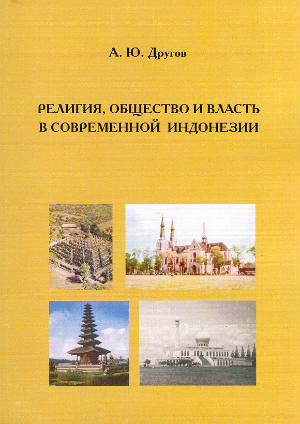Книга
 Религия, общество и власть в современной Индонезии
Религия, общество и власть в современной Индонезии
Другов Алексей Юрьевич
Москва, 2014, 328 стр.
Работа посвящена анализу межконфессиональных и межэтнических проблем, обозначившихся в Индонезии после краха военно-авторитарного режима в 1998 г., социальных и экономических корней этих проблем, борьбы вокруг путей их решения, перспектив и вариантов развития ситуации в этой мультиконфессиональной и мультиэтнической стране. В основу структуры работы положен преимущественно хронологический принцип, который позволяет проследить процессы в их динамике и дает, пусть ограниченные, возможности для их прогнозирования. Вводная глава книги дает краткое освещение отношений между религией, властью и обществом в предшествующие периоды истории страны. В работе широко использованы материалы индонезийской печати и прессы других стран. Ценную информацию и материал для анализа дали исследования и оценки широкого круга государственных, политических, научных и религиозных деятелей современной Индонезии, а также многих иностранных авторов. Это позволило максимально отразить и многообразие идейного и политического спектра этой страны, и противоречивость как ситуации в целом, так и позиций, которые занимают партии, организации и отдельные деятели Индонезии.
English version
This book covers the developments and processes in Indonesia after 1998 when democratic reforms uncovered inveterate ailments of the Indonesian society that previously were excluded from discussion. At the same time limitations upon the activities of Moslem organizations were lifted. Indonesian elite entered the era of reforms rather unprepared and divided, so that the democratization was only partly efficient. This fact together with blossoming corruption undermines the prestige of the state authorities. Under these circumstances the political role of Islam with its religious infrastructure is rising. This process is developing in three dimensions – officially recognized Moslem parties, radical Islam demanding introduction of the Sharia law, sometimes using terror, and grass roots level where local cleric, sometimes radical ones, are dominating. Another threat is the possibility of the army returning to the political stage as the only force able to confront Islamization of the country. As far as economic situation is favorable, these threats are felt as remote, but any crisis might make radical Islam rather attractive. The work is based mainly on chronological order. The introductory chapter of the book gives a brief coverage of the relations between religion, power and society in earlier periods of the history of the country. The author uses extensively the materials of Indonesian and foreign press. Researches and appraisals of a wide range of public, political, scientific and religious figures of modern Indonesia, as well as many foreign authors, provided valuable information and material for the analysis. It allowed reflecting the diversity of ideological and political spectrum of this country, the contradictoriness of the situation as a whole, and the positions of different parties, organizations, and individual activists in Indonesia.


